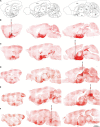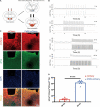Neuroanatomical Basis for the Orexinergic Modulation of Anesthesia Arousal and Pain Control
- PMID: 35558876
- PMCID: PMC9090436
- DOI: 10.3389/fncel.2022.891631
Neuroanatomical Basis for the Orexinergic Modulation of Anesthesia Arousal and Pain Control
Abstract
Hypothalamic orexin (hypocretin) neurons play crucial roles in arousal control. Their involvement in anesthesia and analgesia remains to be better understood. In order to enhance our view on the neuroanatomy, we systematically mapped the projections of orexin neurons with confocal microscope and light sheet microscope. We specifically expressed optogenetic opsins tagged with fluorescence markers in orexin neurons through adeno-associated viral infection in the mouse brain. The imaging results revealed fine details and novel features of the orexin projections throughout the brain, particularly related to the nuclei regulating arousal and pain. We then optogenetically activated orexin neurons in the lateral hypothalamus to study the effects on anesthesia-related behaviors. cFos staining showed that optogenetic stimulation can activate orexin neurons in the ChR2-mCherry group, but not the control mCherry group (62.86 ± 3.923% vs. 7.9 ± 2.072%; P < 0.0001). In behavior assays, optogenetic stimulation in the ChR2-mCherry group consistently elicited robust arousal from light isoflurane anesthesia (9.429 ± 3.804 s vs. 238.2 ± 17.42 s; P < 0.0001), shortened the emergence time after deep isoflurane anesthesia (109.5 ± 13.59 s vs. 213.8 ± 21.77 s; P = 0.0023), and increased the paw withdrawal latency in a hotplate test (11.45 ± 1.185 s vs. 8.767 ± 0.7775; P = 0.0317). The structural details of orexin fibers established the neuroanatomic basis for studying the role of orexin in anesthesia and analgesia.
Keywords: analgesia; anesthesia; hypocretin; light sheet microscopy; optogenetics; orexin.
Copyright © 2022 Xiang, Chen, Li, Fang, Bickler, Guan and Zhou.
Conflict of interest statement
The authors declare that the research was conducted in the absence of any commercial or financial relationships that could be construed as a potential conflict of interest.
Figures






Similar articles
-
Activation of orexin system facilitates anesthesia emergence and pain control.Proc Natl Acad Sci U S A. 2018 Nov 6;115(45):E10740-E10747. doi: 10.1073/pnas.1808622115. Epub 2018 Oct 22. Proc Natl Acad Sci U S A. 2018. PMID: 30348769 Free PMC article.
-
Serotonergic neurons in the dorsal raphe nucleus mediate the arousal-promoting effect of orexin during isoflurane anesthesia in male rats.Neuropeptides. 2019 Jun;75:25-33. doi: 10.1016/j.npep.2019.03.004. Epub 2019 Mar 20. Neuropeptides. 2019. PMID: 30935682
-
Orexin signalling in the nucleus accumbens promotes arousal from isoflurane anaesthesia and restores communication between the nucleus accumbens and frontal cortex.Br J Anaesth. 2025 May 28:S0007-0912(25)00271-5. doi: 10.1016/j.bja.2025.03.042. Online ahead of print. Br J Anaesth. 2025. PMID: 40441984
-
[Role of orexin in the cholinergic ascending arousal system--orexin-induced arousal from anesthesia].Masui. 2007 Jan;56(1):19-29. Masui. 2007. PMID: 17243642 Review. Japanese.
-
Plasticity in neurons synthesizing wake/arousal promoting hormone hypocretin/orexin.Vitam Horm. 2012;89:35-59. doi: 10.1016/B978-0-12-394623-2.00003-2. Vitam Horm. 2012. PMID: 22640607 Review.
Cited by
-
Recent advances in neural mechanism of general anesthesia induced unconsciousness: insights from optogenetics and chemogenetics.Front Pharmacol. 2024 Apr 9;15:1360864. doi: 10.3389/fphar.2024.1360864. eCollection 2024. Front Pharmacol. 2024. PMID: 38655183 Free PMC article. Review.
-
Medial septum glutamatergic neurons modulate nociception in chronic neuropathic pain via projections to lateral hypothalamus.Front Pharmacol. 2023 May 17;14:1171665. doi: 10.3389/fphar.2023.1171665. eCollection 2023. Front Pharmacol. 2023. PMID: 37266154 Free PMC article.
-
The Underlying Mechanisms of Sleep Deprivation Exacerbating Neuropathic Pain.Nat Sci Sleep. 2023 Jul 28;15:579-591. doi: 10.2147/NSS.S414174. eCollection 2023. Nat Sci Sleep. 2023. PMID: 37533626 Free PMC article. Review.
-
Orexinergic lateral hypothalamus (LH) projections to medial septum (MS) modulate ethanol-induced sedation in male and female mice and binge-like ethanol drinking in male mice only.Alcohol. 2024 Mar;115:13-22. doi: 10.1016/j.alcohol.2023.09.003. Epub 2023 Sep 15. Alcohol. 2024. PMID: 37717641 Free PMC article.

